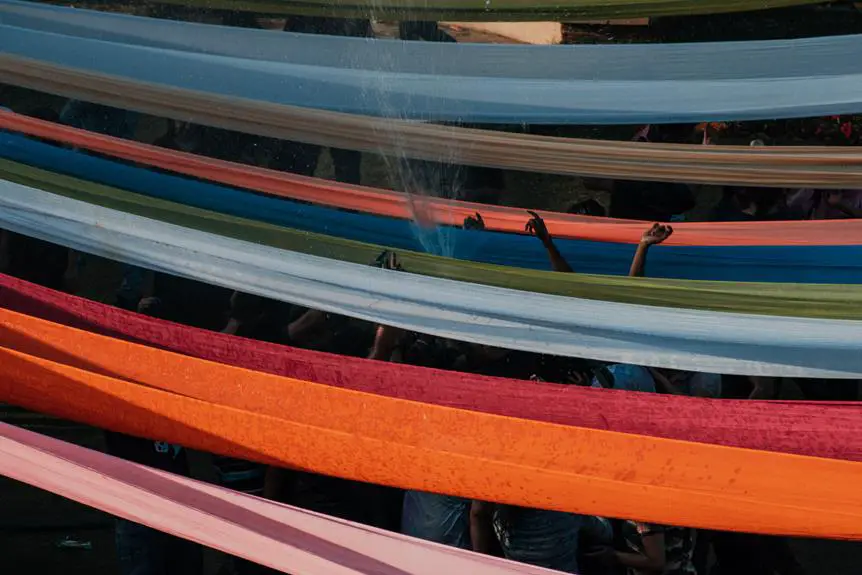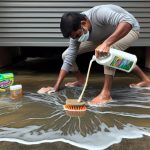Tired of water marks ruining your favorite fabrics? Whether it's your cozy couch or a cherished garment, water marks can be a real pain.
But fear not! With a few simple techniques, you can bid farewell to those stubborn stains and restore your fabrics to their former glory.
From identifying the fabric type to using common household items like vinegar and baking soda, we've got you covered.
Follow these expert tips, and soon you'll be a pro at banishing water marks from any fabric.
So, let's roll up our sleeves and get ready to conquer those pesky stains once and for all!
Key Takeaways
- Examine the care label and understand fabric care recommendations to avoid damage
- Take proactive measures to protect fabric from potential stains and apply fabric protection sprays or solutions
- Blot the stain using a clean, absorbent cloth and avoid rubbing or scrubbing
- Use vinegar and water solution or baking soda paste to remove water marks, and consider professional steam cleaning for stubborn stains
Identifying the Fabric Type
To identify the fabric type, start by examining the care label on the garment for specific instructions. The care label provides valuable information about the fabric and the best way to care for it. Look for symbols or written instructions that indicate whether the fabric can be machine washed, hand washed, dry cleaned, or if it has any special requirements. Understanding the fabric care recommendations will help you choose the appropriate cleaning method and avoid damaging the fabric.
In addition to identifying the fabric type, understanding the stain prevention techniques for different fabrics is crucial. Some fabrics are more prone to staining and require specific precautions to prevent and remove stains effectively. By knowing the characteristics of the fabric, you can take proactive measures to protect it from potential stains. This may involve using fabric protectors, avoiding certain substances that can cause stains, or taking immediate action to treat stains before they set.
Blotting the Stain
Once you have identified the fabric type and assessed the potential for staining, you can proceed to blot the water mark from the fabric using a clean, absorbent cloth. The blotting technique is highly effective in lifting water marks from fabrics. Start by gently pressing the cloth onto the stained area, allowing it to absorb the moisture. Avoid rubbing or scrubbing, as this can spread the stain and damage the fabric fibers. Instead, continue blotting until no more moisture transfers to the cloth.
Common mistakes in blotting technique include using a colored or printed cloth, which can transfer dyes onto the fabric you're trying to clean. Additionally, applying too much pressure while blotting can push the stain deeper into the fabric, making it more difficult to remove. It's important to be patient and persistent when blotting, as rushing the process can lead to incomplete stain removal.
Using Vinegar and Water Solution
You can create a solution by mixing one tablespoon of white vinegar with two cups of water to remove water marks from fabrics. Vinegar is an effective natural cleaner and can help break down the minerals or impurities in the water that have caused the marks. It's important to test the solution on a small, inconspicuous area of the fabric first to ensure it doesn't cause any damage or discoloration.
To use the vinegar and water solution, dampen a clean cloth with the mixture and gently dab at the water marks. Avoid rubbing too vigorously, as this can spread the stain or damage the fabric fibers. After dabbing the affected area, allow it to air dry. Once dry, check to see if the water marks have been successfully removed. If the marks are still visible, you can repeat the process or consider trying vinegar alternatives such as lemon juice or baking soda.
In addition to removing water marks, using a vinegar and water solution can also serve as a preventive measure. After washing or treating the fabric, you can use this solution as a final rinse to help prevent future water marks from forming.
Applying Baking Soda Paste
Try applying a baking soda paste to the water marks on the fabric using a clean cloth and gentle circular motions. Baking soda is one of the most effective natural alternatives for removing water marks and stains from fabric. It is gentle on the fabric and helps to absorb moisture and odor. Here's how you can make a baking soda paste:
| Ingredients | Measurements |
|---|---|
| Baking soda | 2 tablespoons |
| Water | 1 tablespoon |
| Clean cloth | – |
To create the paste, mix two tablespoons of baking soda with one tablespoon of water in a small bowl. Stir the mixture until it forms a smooth paste. Using a clean cloth, apply the baking soda paste to the water marks on the fabric, using gentle circular motions. Allow the paste to sit on the fabric for 15-20 minutes, then gently blot it off with a clean, damp cloth. Finally, allow the fabric to air dry. This method is not only effective in removing water marks, but it also helps in fabric care, preserving the quality of the material.
Steam Cleaning the Fabric
To steam clean the fabric, you can use a handheld steamer or the steam function on your iron. Simply hover the steamer or iron over the water marks, allowing the steam to penetrate the fabric and loosen the marks.
For more stubborn water marks, consider professional steam cleaning as an effective option.
Using Handheld Steamer
To effectively remove water marks from fabrics, start by using a handheld steamer to steam clean the fabric. Here are some tips for using a handheld steamer to effectively remove water marks:
- Fill the handheld steamer with water and allow it to heat up.
- Hold the steamer a few inches away from the fabric and move it in a sweeping motion to distribute the steam evenly.
- Pay extra attention to the water-marked areas, as the steam will help loosen the fibers and remove the marks.
- For stubborn water marks, consider adding a small amount of vinegar to the water in the steamer to enhance its cleaning power.
Using a handheld steamer is a convenient way to effectively remove water marks from fabrics, and it can be a preferable option to steamer alternatives or DIY fabric steaming techniques.
Steam From Iron
How effectively can you use the steam from an iron to remove water marks from fabrics? When it comes to iron maintenance and removing wrinkles, using the steam function of your iron can be an effective way to remove water marks from fabrics. The hot steam helps to relax the fibers of the fabric, allowing the water marks to dissipate. To effectively use the steam from your iron, follow these tips:
| Iron Maintenance | Removing Wrinkles | Steam Cleaning | Effectiveness |
|---|---|---|---|
| Regular cleaning of the steam vents | Use a pressing cloth to protect the fabric | Hold the iron slightly above the fabric and release bursts of steam | Highly effective in removing water marks |
Professional Steam Cleaning
You can achieve even more effective removal of water marks from fabrics by employing professional steam cleaning techniques that thoroughly penetrate and cleanse the fabric.
Professional steam cleaning offers several benefits for fabric maintenance, including:
- Deep penetration to lift water marks from the fabric fibers
- Effective removal of stubborn stains and discoloration
- Sanitization of the fabric to eliminate odors and bacteria
- Restoration of the fabric's original texture and appearance
When seeking professional cleaning services, inquire about their experience with steam cleaning fabrics and their methods for ensuring the best results.
Professional steam cleaning can revitalize your fabrics and eliminate water marks, providing a fresh and renewed look for your belongings.
Trying Lemon Juice and Salt Mixture
Mix a small amount of lemon juice with an equal part of salt to create a paste for treating water marks on fabrics. This natural alternative is a simple DIY fabric care method that can help remove water marks without the need for professional cleaning. The acidity of the lemon juice combined with the abrasive texture of the salt can work together to lift the water marks from the fabric.
To apply this method, begin by mixing the lemon juice and salt together to form a paste. Then, gently rub the paste onto the water marks, ensuring that it covers the affected areas completely. Allow the paste to sit on the fabric for about half an hour to let it work its magic.
After the paste has had time to set, use a damp cloth to gently blot and wipe away the mixture. Be sure to test this method on a small, inconspicuous area of the fabric first to ensure that it doesn't cause any damage or discoloration.
This simple DIY approach using lemon juice and salt provides an effective and natural way to tackle water marks on fabrics, offering an alternative to professional cleaning methods.
Using Commercial Stain Removers
To effectively tackle water marks on fabrics, consider utilizing a commercial stain remover's powerful formula. Commercial stain removers offer a convenient and effective solution for removing stubborn water marks from fabrics. Here are some key points to keep in mind when using commercial stain removers:
- Versatility: Commercial stain removers are designed to work on a variety of fabric types, making them a versatile option for stain removal.
- Efficiency: These products are formulated to target tough stains, including water marks, and can often deliver quick and efficient results.
- Safety: Look for commercial stain removers that are safe for the specific type of fabric you're treating to avoid any potential damage.
- Fabric care maintenance: When using a commercial stain remover, it's important to follow the manufacturer's instructions carefully to ensure proper fabric care maintenance.
When considering stain removal alternatives, commercial stain removers can be a reliable choice for effectively treating water marks on fabrics. By understanding how to use these products safely and effectively, you can maintain the quality of your fabrics while keeping them free from unsightly water marks.
Preventing Future Water Marks
To prevent future water marks on your fabrics, consider applying fabric protection sprays or solutions to create a barrier against moisture.
Additionally, always ensure that fabrics are thoroughly dried after cleaning or exposure to water, as lingering moisture can lead to water marks.
Lastly, choosing stain-resistant fabrics for your furniture or clothing can also help minimize the risk of water marks and make cleaning easier in the long run.
Fabric Protection Tips
To prevent future water marks on fabrics, you should regularly apply a fabric protector spray to create a barrier against liquid absorption. This will help keep your fabrics looking clean and free from water stains.
Here are a few fabric protection tips to help you maintain the quality of your fabrics:
- Choose a high-quality fabric protector spray specifically designed for the type of fabric you want to protect.
- Test the fabric protector spray on a small, inconspicuous area of the fabric before applying it to the entire surface.
- Follow the manufacturer's instructions carefully when applying the fabric protector spray to ensure proper coverage.
- Reapply the fabric protector spray periodically, especially after cleaning or washing the fabric, to maintain its effectiveness.
Proper Drying Techniques
Ensure your fabrics dry completely before storing them to prevent water marks from forming. When air drying, it's best to lay the fabric flat on a clean, dry surface, flipping it occasionally to ensure even drying.
Avoid hanging delicate fabrics as this can cause stretching and misshaping. If using a dryer, check the manufacturer's recommendations for heat settings to prevent damage. Using a low-heat setting and removing the fabric promptly when dry can help prevent water marks.
It's important to avoid excessive heat, as it can set any remaining water marks, making them more difficult to remove. By following proper drying techniques, you can minimize the risk of water marks and keep your fabrics looking their best.
Stain-Resistant Fabric Options
When air drying your fabrics, you can minimize the risk of water marks by choosing stain-resistant fabric options that repel moisture and prevent staining. Consider the following options to prevent future water marks:
- Invest in fabrics treated with waterproofing techniques to create a barrier against moisture.
- Look for fabrics with built-in stain-resistant properties for added protection.
- Incorporate fabric care routines, such as using specialized detergents and fabric protectants, to maintain the stain resistance.
- Choose fabrics with tight weaves or synthetic fibers that naturally repel water and stains.
Frequently Asked Questions
Can I Use the Same Method to Remove Water Marks From Delicate Fabrics Like Silk or Wool?
You can use steam to remove water marks from delicate fabrics like silk or wool. Be cautious to prevent damage by using a gentle touch. Steam helps lift the marks without harming the delicate fibers.
Will Using a Vinegar and Water Solution Cause Any Discoloration or Damage to the Fabric?
Using a vinegar solution on delicate fabrics like silk or wool can potentially cause discoloration or damage. It's important to test the solution on a small, inconspicuous area first to ensure it won't harm the fabric.
Are There Any Specific Types of Fabrics That Should Not Be Treated With a Baking Soda Paste?
When dealing with fabric care and stain prevention, it's essential to be mindful of chemical reactions and fabric composition. Some delicate fabrics like silk or wool should not be treated with a baking soda paste to avoid potential damage.
Can Steam Cleaning Be Used on All Types of Fabrics to Remove Water Marks?
Yes, steam cleaning is effective for removing water marks on most fabrics, but it's important to check fabric compatibility beforehand. Some delicate fabrics may not withstand the heat and moisture of steam cleaning, potentially causing damage.
Are There Any Specific Types of Commercial Stain Removers That Are More Effective for Removing Water Marks From Fabrics?
When removing water marks from fabrics, certain commercial stain removers work best. Consider using eco-friendly options to minimize environmental impact. Preventing water marks involves proper drying techniques and avoiding prolonged exposure to moisture.
- Tetron Fabric for Marine Applications: Durability and Use Cases - June 18, 2025
- Tetron Fabric for Outdoor Furniture: Weather Resistance and Care - June 18, 2025
- Tetron Fabric for Wall Coverings: Style and Application Tips - June 18, 2025







